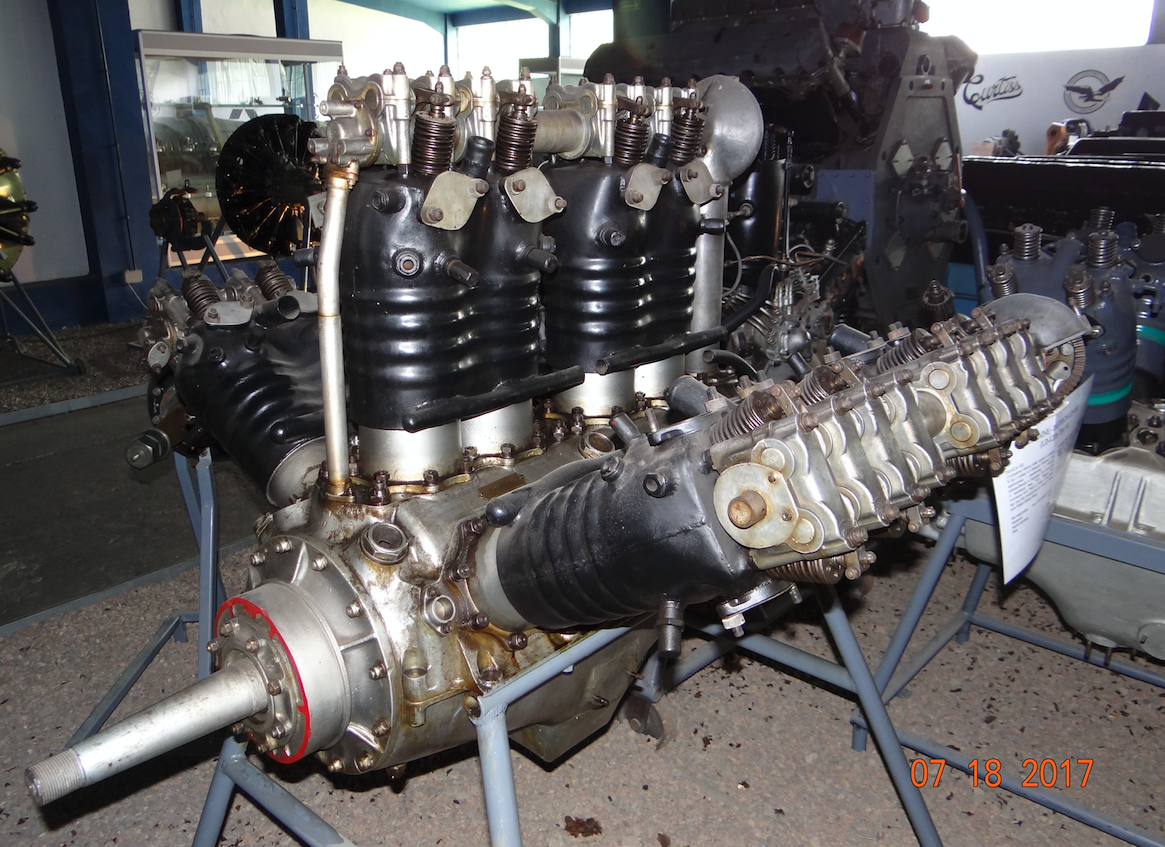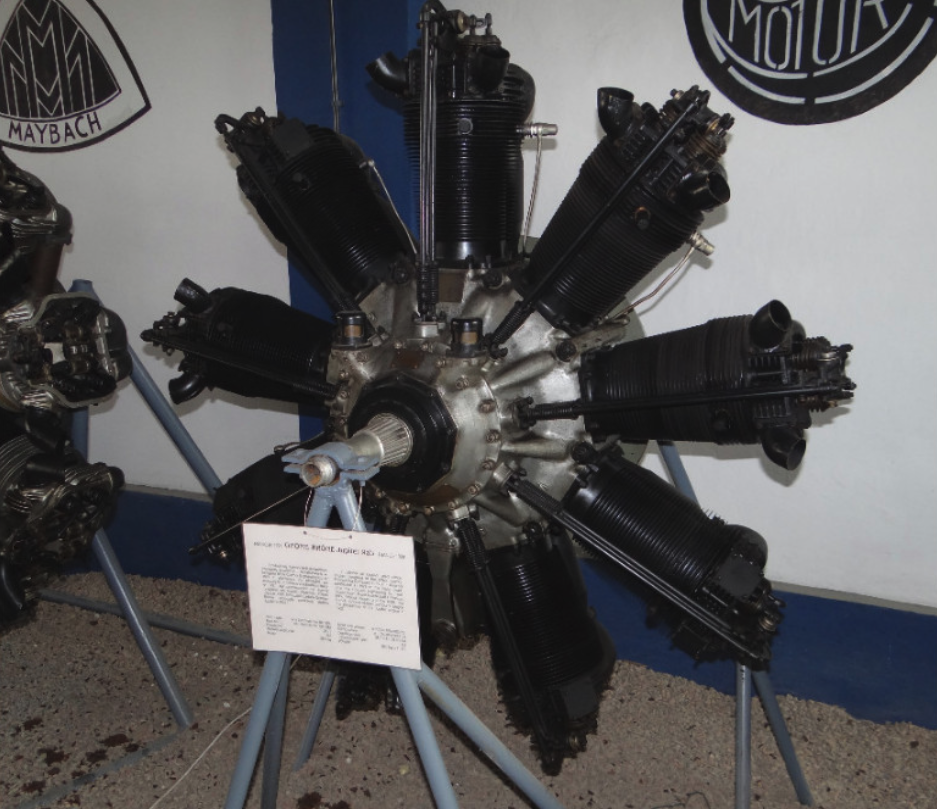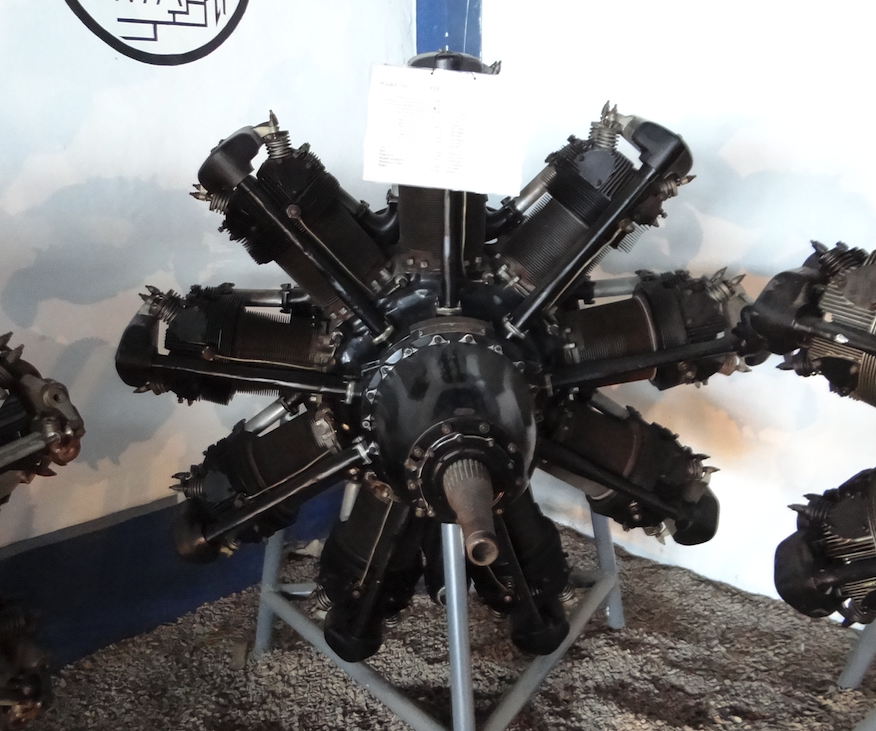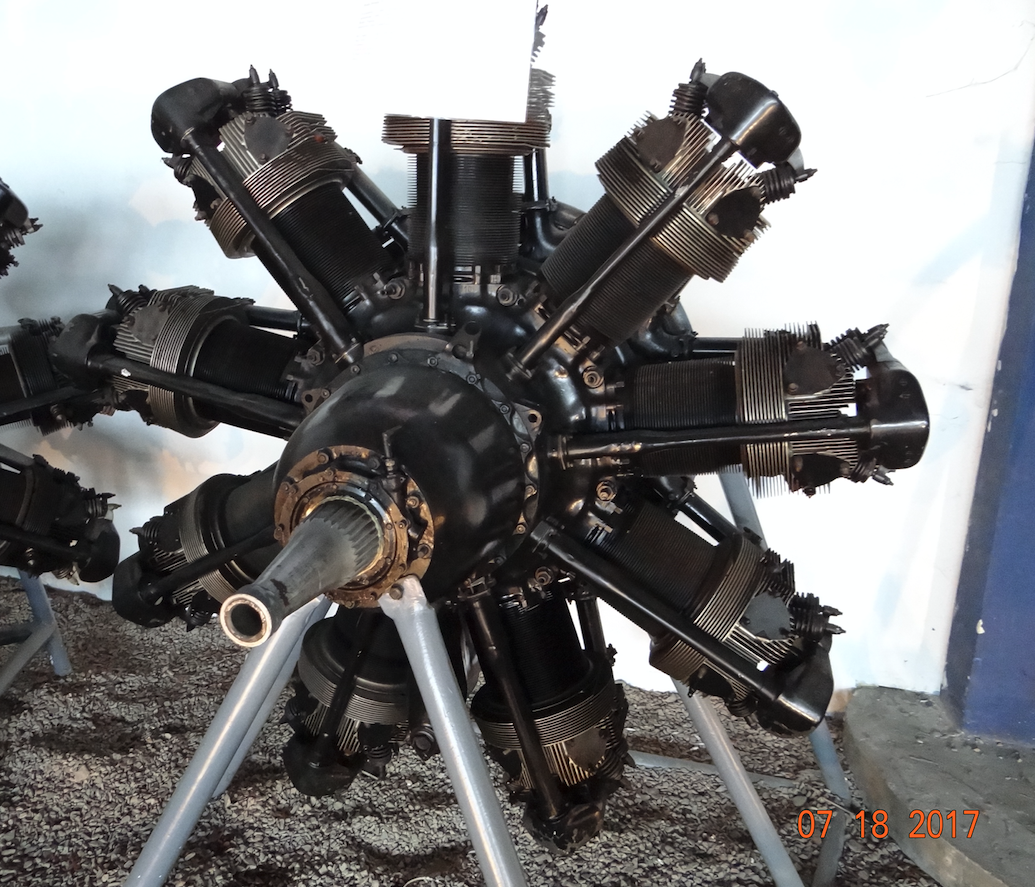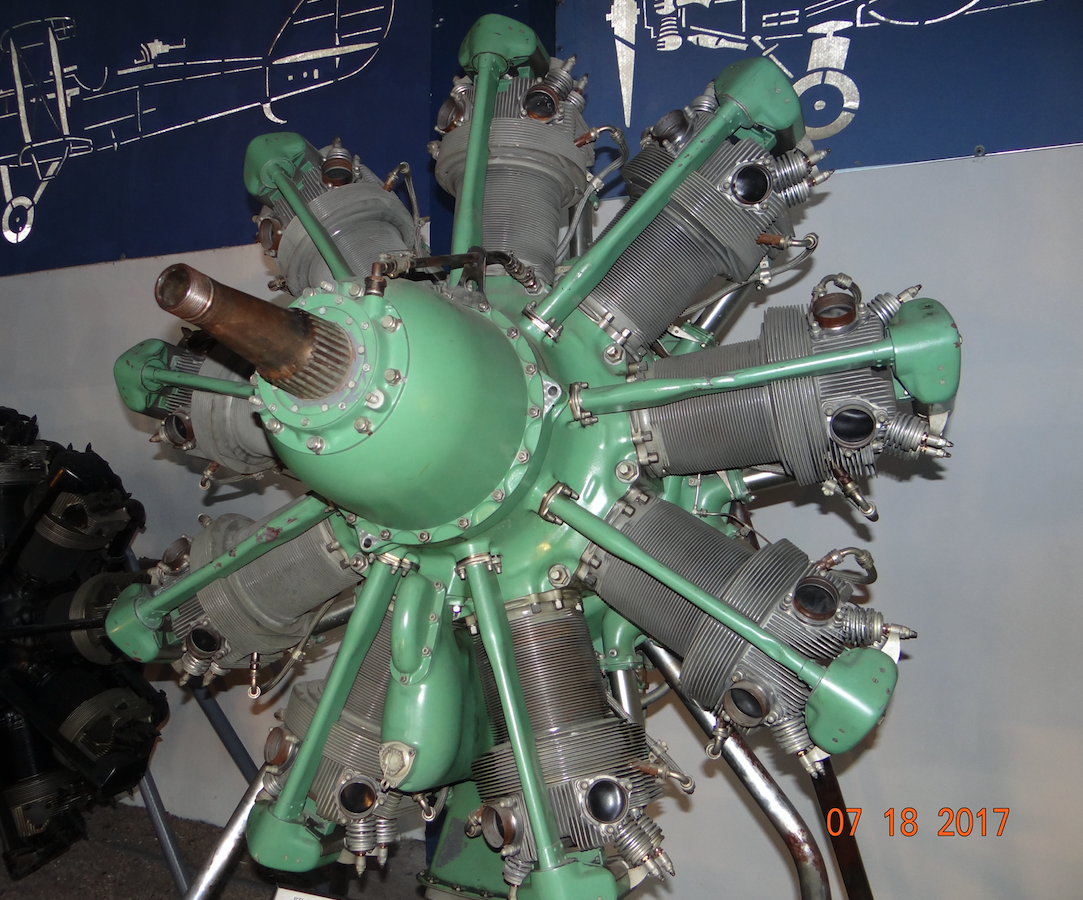Kraków 2016-05-20
Silnik spalinowy, tłokowy, gwiazdowy.
Produkcja w Polsce.
Silniki gwiazdowe, opracowane przez Polskich konstruktorów nie zabezpieczyły większości potrzeb Polskiego Lotnictwa. Mieliśmy utalentowanych konstruktorów, ale brakowało nam zaplecza technicznego, a przede wszystkim funduszy. Trzeba pamiętać, że opracowanie dobrego silnika lotniczego jest długie (4-6 lat) i wymaga przeprowadzania wielu testów. Konieczne jest znaczne zaangażowania przemysłu hutniczego, metalowego i maszynowego. Tak było w 20-latach XX wieku i tak jest sto lat później. Opracowanie silnika i uzyskanie zakładanej mocy, wcale nie oznacza, że silnik jest udany. Może być ciężki, paliwożerny lub mieć problemy z utrzymaniem optymalnej temperatury pracy. Może być awaryjny i mieć krótki resurs. Problemów jest wiele.
W latach 1926-1928, Departament Aeronautyki Ministerstwa Spraw Wojskowych prawidłowo ocenił, że nie będziemy w stanie w najbliższych latach sami skonstruować dobrych silników w Polsce. Podjęto decyzje o zakupie licencji, dla utworzonych w 1926 roku, Polskich Zakładów Skoda. W czerwcu 1926 roku, nowo mianowany szef Departamentu IV Żeglugi Powietrznej pułkownik Ludomił Rayski zwrócił się do silnikowych wytwórni zagranicznych: Lorraine-Dietrich, Hispano-Suiza, Issota Francini, Rolls-Royce, Bristol i Skoda z propozycją przejęcia firmy Frankopol. Gwarantowano wówczas ulgi podatkowe i inne udogodnienia na okres 10 lat i zakup w tym okresie minimum 1 500 silników przez Ministerstwo Spraw Wojskowych. Część zagranicznych wytwórni nie była zainteresowana. Inne wykazywały minimalne zainteresowanie. Większe zainteresowanie okazała tylko koncern Skoda, który wyraził gotowość produkcji silników na terenie Rzeczypospolitej Polskiej. Postawili jednak warunki: 10-letnia umowa ramowa, w zakładzie nie będzie odlewni i kuźni (komponenty będą sprowadzane z Czechosłowacji), samodzielny wybór kontrahentów zagranicznych, uzyskanie gwarancji rządowych oraz nie obciążanie wierzytelnościami firmy Frankopol.
Warto w tym miejscu zwrócić uwagę na inne, pozatechniczne aspekty problemów związanych z budową silników lotniczych w Polsce. Firma Skoda była w znacznym stopniu kontrolowana przez francuzów. Zakłady w Czechosłowacji były dobrze rozwinięte i nie uległy zniszczeniu w czasie wielkiej wojny światowej. Czechosłowacja była żywo zainteresowana w utrzymaniu swojego potencjału produkcyjnego, w obliczu dużego spadku zapotrzebowania na sprzęt wojskowy i lotniczy. Oferowali bogaty zestaw prefabrykatów hutniczych, w postaci wyrobów walcowanych i kutych. Czesi sami przyjechali do Polski poszukując rynku zbytu na swoje wyroby. Byli zainteresowani uruchomieniem fabryki samochodów, maszyn rolniczych i silników elektrycznych. Od razu zauważyli brak odpowiedniej infrastruktury i trudności z pozyskaniem wykształconych pracowników. Zrezygnowali z proponowanych lokalizacji w Tarnowie, Rzeszowie, Kielcach i Dęblinie. Ewentualni pracownicy o dużym potencjale technicznym byli tylko w Warszawie. Dlatego Czesi zaproponowali własną kadrę inżynieryjną. Jednak w tym przypadku zaprotestowało Wojsko Polskie. Nie chcieliśmy obcych pracowników. Jednak Czesi zwrócili także uwagę na duże i nie do końca przemyślane zakupy sprzętu lotniczego we Francji i duże redukcje w planach mobilizacyjnych Wojska Polskiego, co mogło źle wróżyć wielkości przyszłej produkcji.
Decyzje w sprawie zakupu większościowego pakietu akcji Spółki Frankopol przez koncern Skoda i podjęcie produkcji silników lotniczych zapadły na samych szczytach Polskiej Administracji. Umowę w dniu 15.11.1926 roku, podpisano w obecności Prezydenta Ignacego Mościckiego, Marszałka Józefa Piłsudskiego, generała Aleksandra Litwinowicza, pułkownika Ludomiła Rayskiego. Tak powstały Polskie Zakłady Skoda. Potocznie mówiono Polska Skoda.
Co ciekawe, zakłady Skoda miały małe doświadczenie w produkcji silników lotniczych. Co prawda, już w 1909 roku, Zakłady Laurin et Klement w Mlada Bolesłav zbudowały pierwszy silnik lotniczy. Jednak była to produkcja pojedynczych silników na indywidualne zamówienia entuzjastów awiacji. Produkcja seryjna silnika Lorraine-Dietrich 12 w Czechosłowacji ruszył dopiero w 1924 roku. Brak doświadczeń w tej dziedzinie okazał się korzystny dla Polskiej strony, dlatego, że Polska mogła kupić licencje tych silników, które chciała, sprawdzonych w lotach, a nie konstrukcji przypadkowych, będących na początku realizacji programu. Zakupy licencji silników zapewniło Polsce stabilny rozwój Polskiego Przemysłu Lotniczego.
Umowa z Czechami i powstanie Polskich Zakładów Skoda była bardzo korzystna dla kupujących, ale także dość dobre zabezpieczała interesy Rzeczypospolitej Polskiej. W miejsce nierzetelnej Spółki Frankopol, weszła firma z dużym doświadczeniem handlowym, produkcyjnym i kapitałem. Umowa dojść dobrze zabezpieczały bezpieczeństwo kraju. Przekroczenie terminu (30.11.1927 roku) uruchomienia wytwórni miało skutkować unieważnieniem kontraktu, zwrotem zaliczek wypłaconych Spółce Frankopol oraz odszkodowaniem w wysokości 100 tysięcy $. Władze Polskie stworzyły także furtkę dla przyszłego rozwiązania umowy i pozbycia się Czechów: Trzykrotne przekroczenie terminu dostaw dla Polskiego Wojska lub podjęcie produkcji dla obcego kraju.
Silniki produkowane przez Polskie Zakłady Skoda były droższe od innych, bo zakład musiał spłacić długi wobec prywatnych wierzycieli, w okresie 10 lat. W ciągu 10 lat zakłady miały: zbudować 1 500 silników lotniczych, wyremontować kolejne 1 500 sztuk i dostarczyć części zamiennych w wysokości 15 % globalnego zamówienia. Ponieważ podejrzewano, że ceny silników mogą być wygórowane, dlatego od razu powołano komisję arbitrażową. Orzeczenia komisji były wiążące.
Pierwszym działaniem koncernu Skoda była budowa zakładu, którą prowadziły firmy Czechosłowackie i Polskie. Prace trwały na dwie zmiany. Nadzorował je inż. Antoni Novotny. W październiku 1927 roku, ukończono hale obrabiarek o powierzchni 2 000 m2. Zbudowano wieżę ciśnień, instalację wodociągową, kotłownię, instalację centralnego ogrzewania, sieć kanalizacyjną. W kwietniu 1928 roku, oddano do użytku magazyny, bocznicę kolejową, kuźnię i stołówkę dla pracowników. Po Spółce Frankopol zakład przejął około 280 obrabiarek. Część z nich wykorzystano, ale znaczną część musiano sprzedać, bo były one kupione dla produkcji płatowców, a nie silników. Nowe obrabiarki kupiono w angielskich firmach: Sleeper i Hartley, Alfred Herbert, Webster & Bennet, James Archdle i w innych krajach. W kolejnych latach park maszyn ulegał częściowej wymianie.
Rozpoczęto także przygotowywanie do pracy kadry inżynieryjnej. Kilku pracowników wysłano do zakładów koncernu Skoda w Pilznie i Mlada Bolesłav oraz do zakładów Lorraine-Dietrich w Luneville koło Nancy w zachodniej Francji. W 1927 roku, wytwórnia zatrudniała już 200 pracowników, aby w kolejnych latach zatrudniać 1 500 osób. W 30-latach zakład mieścił się w pierwszej dziesiątce zakładów przemysłu maszynowego, pod względem parku maszynowego i zatrudnionych pracowników.
Jedną z pierwszych konstrukcji Polskich Zakładów Skoda był wspomniany w poprzednim Rozdziale, Polski silnik inż. Stanisława Nowkuńskiego oznaczony G-594 „Czarny Piotruś” o mocy 100 KM (88 kW), przy 1 940 obr/min. Była to 7-cylindrowa gwiazda. Jego produkcja trwała w latach 1928-1931. Prace nad silnikiem zapoczątkowano jesienią 1928 roku. Silnik miał zaledwie 5,94 litra pojemności i przy tym uzyskał niezwykle wysokie parametry. Było to efektem zastosowania dużego sprężu (stopnia sprężania), oraz zastosowanie sprężarki (doładowania). Zużycie paliwa było niskie i wynosiło zaledwie 240 g/KM/h. Zastosowanie sprężarki spowodowało, że silnik miał dobre parametry nawet na pułapie 7 000 m. Próby silnika przeprowadzono na samolocie szkolno-treningowym Bartel MB-4. Trwały one około 100 godzin. Oględziny silnika wykazały jego minimalne zużycie. W dniu 11.06.1931 roku, z Oddziału I Sztabu Głównego wpłynęło zamówienie na seryjne silniki G-594 „Czarny Piotruś”, których produkcja miała się rozpocząć po zakończeniu procesu homologacji. Jednak prace nad silnikiem trwały nadal. Silnik z 7-cylindrowego stał się 9-cylindrowy i uzyskał oznaczenie G-760, co oznacza, że ma pojemność 7,60 litra. Silnik miał moc 260 KM przy masie 137 kg, co dało prawie 2 KM z jednego kilograma konstrukcji, a to było doskonałym wynikiem. O tym silniku była także mowa w poprzednim Rozdziale.
W 1926 roku, Departamentu IV Żeglugi Powietrznej zdecydował o podjęciu zakupów licencyjnych. Na początek zakupiono licencję francuskich silników Lorraine-Dietrich, o mocy 400 KM i 450 KM. W grudniu 1926 roku, doszło do podpisania porozumienia pomiędzy firmą Skoda, a licencjodawcą Lorraine-Dietrich. W formie kredytu firma Lorraine-Dietrich dostarczała korbowody, cylindry, rozrządy oraz kartery. W okresie 1928-1930, wytwórnia Polskie Zakłady Skoda zbudowała 300 silników Lorraine-Dietrich 12, o mocy 450 KM. W późniejszych latach wykonywano tylko remonty tych silników i dostarczano części zamienne. Współpraca z firmą Lorraine-Dietrich została zakończona z uwagi na przejście na produkcję silników chłodzonych powietrzem. Była to decyzja bardzo dobra, a jej inicjatorem był między innymi pułkownik pilot Ludomił Rayski.
Opis do zdjęcia: Silnik miał kilka oznaczeń: Lorraine-Dietrich LD 450 (LD-12Eb, Typ 14). Silnik opracowano we Francji, w Argenteil, w 1922 roku. Jest to silnik rzędowy w układzie "W". Cylindry umieszczono po dwa cylindry w 6 blokach. Silnik jest chłodzony cieczą. Ma moc maksymalną 450 KM, przy 1 850 obrotów na minutę. Pojemność 24,4 litrów. Stopień sprężania wynosi 6,1:1. Masa silnika 435 kg. Silnik produkowano w Polsce. Silnik montowano na samolotach: Potez XXV, Breguet XIX, Levavasseur PL.8, PWS-10, Fokker F.VII.
W 1930 roku, strona Polska nalegała na uruchomienie odlewni podzespołów silników w zakładzie w Ursusie. Jednak program ten rozwijał się opornie. Nie udało się wykonać dobrej jakości karterów. W efekcie nastąpiły opóźnienia dostaw silników. Dlatego Polskie Wojsko zdecydowało o budowie własnej odlewni. Prace ruszyły w 1933 roku.
W historii wytwórni silników Polskie Zakłady Skoda w Warszawie ważnym był rok 1933. W tym to roku zakład po raz pierwszy w historii przygotował kompletną dokumentację, instrukcje i oprzyrządowanie dla nowego silnika Bristol Mercury. Do tej pory większość tych zadań wykonywano w Pilznie.
Silniki Pegaz.
Dalsze Polskie zakupy licencyjne były bardzo trafne. Podpisano umowę z brytyjską firmą Bristol. Powszechna była wówczas opinia, że silniki francuskie mają dobrą konstrukcję, ale są wykonane nieco gorzej. Zaś technologię brytyjską ceniono bardzo wysoko. Umowa z firmą Bristol dotyczyła nie tylko silnika Bristol Jupiter, ale także wszystkich kolejnych rozwojowych konstrukcji. Zakupy te pozwoliły całkowicie zaspokoić Polskie potrzeby w pierwszej połowie 30-lat XX wieku. Dla samolotów myśliwskich silniki Jupiter, a nieco później Merkury. Dla samolotów rozpoznawczo-bombowych i bombowców silniki Pegaz.
Rozmowy z firmą Bristol prowadzono poprzez jej przedstawiciela firmę Gnome-Rgone. Dlatego silniki Bristol Jupiter w Polsce nazywano Gnome-Rgone Jupiter. Umowę podpisano w dniu 8.08.1929 roku. W końcu maja 1930 roku, zamówiono kartery produkowane w zakładach Bristol. Było to spowodowane niedotrzymaniem reizmów parametrów w partii próbnej karterów. Nie sprostały temu ani zakład w Ursusie ani w Pilznie. Również Huta Bismarcka początkowo nie poradziła sobie z uzyskaniem odpowiedniej jakości. Pierwsze silniki z Polskich Zakładów Skoda zostały dostarczone w maju 1932 roku. Cena katalogowa silnika wynosiła 90 tys złotych. W okresie 1932-1934 zbudowano 170 silników PZL Bristol Jupiter F.VII o mocy 485 KM. Na linii produkcyjnej silnik został zastąpiony silnikiem Bristol-Mercury.
Silnik Bristol Jupiter to 9-cylindrowa pojedyncza gwiazda, zbudowany pod koniec wielkiej wojny światowej przez Bristol Aeroplane Company. Początkowo był nazywany Cosmos Jupiter (Kosmos Jowisz). W wyniku udoskonaleń i zmian stał się jednym z najlepszych silników lotniczych swojej epoki. Licencja została sprzedana do wielu krajów. Był pierwszym w pełni udanym silnikiem z doładowaniem. Jupiter był jednym z pierwszych silników w którym zastosowano cztery zawory na cylinder. Standardowy silnik miał spręż 6,3:1. Cylindry wykonywano ze stalowych odkuwek, a głowice ze stopów aluminium. Później głowice wykonywano także ze stalowych odkuwek. Stosowano także reduktor. W 1925 roku, rozpoczęto projektowanie następcy Jupiter (Jowisz), którym stał się w 1927 roku, Bristol Merkury. Zastosowano krótszy skok tłoków, aby zwiększyć prędkość obrotową, a przez to moc. Zastosowanie tej technologi w oryginalnym rozmiarze silnika Jupiter doprowadziła do powstania odmiany Bristol Pegasus. W 1926 roku, przeprowadzono test silnika Jupiter zamontowanego na samolocie Bristol Bloodhund. Silnik pracował bezawaryjnie 225 godzin i 54 minuty, a samolot pokonał 25 074 mil.
Silnik Bristol Jupiter był produkowany z licencji w czternastu krajach. Najwięcej poza UK zbudowano tych silników we Francji, gdzie produkcję prowadziła firma Gnome-Rhone pod oznaczeniem Gnome-Rhone 9 Jupiter. Silniki budowano w Japonii (Nakajima), we Włoszech (Alfa Romeo), Czechosłowacji (Walter), w CCCP (Shvetsov M-4) i wielu innych krajach. Trudno doliczyć się ile silników zbudowano. W samej wytwórni Alfa Romeo powstało ich około 11 000 sztuk.
Starania o podjęcie w Warszawie produkcji silników PZL Bristol Mercury wynikała z dalekowzrocznej polityki wodzów Wojska Polskiego i chęci posiadania odpowiedniego silnika dla samolotu myśliwskiego. Decyzja o uruchomieniu produkcji silników PZL Bristol Mercury IV S2 zapadła w październiku 1932 roku, w gabinecie szefa Sztabu Głównego generała Janusza Gąsiorowskiego. Wynikała ona z konieczności zapewnieniom samolotom myśliwskim zespołu napędowego o mocy rzędu 600-800 KM.
Warto w tym miejscu zaznaczyć, że firma Bristol unikała rewolucyjnych rozwiązań konstrukcyjnych, co u innych firm przejawiało się silnikami o mocy 1 000 KM. Zapóźnienie to firma Bristol odrobiła w 1938 roku, ale dla Polskiego Przemysłu Lotniczego było już za późno. Należy także pamiętać, że silniki o mocy 1 000 KM z początkiem 30-lat miały bardzo krótki resurs.
Od końca 1932 roku, Polskie Zakłady Skoda współpracowały bezpośrednio z firmą Bristol bez pośrednika jakim była firma Gnome-Rhone. Usprawniło to przepływ informacji i redukowało koszty współpracy. Zakład w Ursusie nadal brał udział w programie. Jednak z 19 sztuk pokryw sprężarek tylko 6 zostało przyjętych. Inne odlewy także miały duży odsetek niespełniających norm. Głównym powodem była ich porowatość, a przez to przesiąkanie olejów i smarów. Odlewy zaczęła wykonywać angielska huta High Duty All. Pierwsze silniki PZL Bristol Mercury dostarczono we wrześniu 1933 roku. Produkcja wynosiła 7 sztuk miesięcznie i osiągnęła poziom 20 sztuk w miesiącu. Zbudowano około 200 silników. Cena katalogowa silnika Bristol Mercury V S2 (o mocy 595 KM) wynosiła 90 tys złotych.
PZL Pegaz VIII to udoskonalony silnik Bristol Siddeley, produkowany w Wytwórni Silników nr 1 w Warszawie–Okęciu z licencji. Zastąpił w produkcji gorszy silnik Pegaz II. W latach 1936–1937, w Warszawie wyprodukowano ponad 350 silników tego typu. Silnik PZL Pegaz VIII był stosowany w samolotach: PZL.23 B Karaś, PZL.30, PZL.42.
Dane silnika PZL Pegaz VIII: gwiazda, 9-cylndrów, pojemność 28,7 litrów. Stopień sprężania 6,0:1. Redukcja obrotów śmigła 0,655. Masa silnika 470 kg. Moc maksymalna 705 KM przy 2 600 obrotach na minutę. Moc nominalna 665 KM przy 2 250 obrotach na minutę.
Silnik PZL Pegaz XX, przeznaczony był dla samolotów PZL.37 Łoś i PZL.46 Sum. Silnik ten napędzał najnowocześniejszy samolot Polskiego Lotnictwa Wojskowego w 1939 roku. Silnik PZL Pegaz XX był produkowany przez Wytwórnię Silników nr 1 w Warszawie-Okęciu z licencji. Silnik PZL Pegaz XX był wyposażony w sprężarkę i reduktor oraz gaźnik typu Cloudel-Hobson AVT 80BZ firmy Motolux. Silnik napędzał śmigło przestawialne, dwustopniowe, trójłopatowe, metalowe De Havilland Hamilton Standard. Ten silnik był na ekspozycji prezentowany w pawilonie polskim na światowej wystawie w New York, latem 1939 roku. Po wybuchu drugiej wojny światowej pozostał w USA, w rękach prywatnych. W 2006 roku, eksponat przekazał do zbiorów Muzeum Lotnictwa Polskiego w Krakowie Pan Witold Dewicki z Fowlerville w stanie Michigan.
Silniki Whirlwind.
Razem z licencją silników Bristol Jupiter zakupiono licencje na Amerykańskie silniki Whirlwind dla samolotów szkolno-treningowych i łącznikowo-obserwacyjnych. Silnik Wright Whirlwind R-790 o mocy 220 KM (162 kW). Historia silnika sięga 1921 roku, kiedy to firma Lawrance Aero Engine Company rozpoczęła prace nad silnikiem dla US NAVY. Marynarka oceniła, że silnik chłodzony powietrzem jest dużo bardziej korzystny dla samolotów morskich niż silniki chłodzone cieczą. Właściciel silnika nie miał mocy produkcyjnych. Wielcy producenci silników Wright i Curtiss, nie byli zainteresowani, bo twierdzili, iż ich konstrukcje chłodzone cieczą są bardzo dobre. Wówczas US NAVY, będąca głównym odbiorcą silników firmy Wright zaszantażowała producenta, że poszuka innego dostawcy. W 1923 roku, firma Wright została zmuszona do zakupu licencji silnika Lawrance J-1, który zmienił oznaczenie na Wright J-1. Z czasem cała firma Lawrance Aero Engine Company została wchłonięta przez koncern Wright. Powstały wówczas kolejne odmiany silnika, które zużywały mnie paliwa i były bardziej niezawodne. Tylko pierwszy model silnika nosił nazwę Whirlwind (trąba powietrzna). Kolejne modele oznaczano kodowo od J-2 do J-5, i otrzymał nowe oznaczenie R-790. Nazwa ta oznacza pojemność silnika, czyli 788 cali sześciennych, czyli 12,91 litrów.
Silnik R-790 ma 9-cylindrów, pojemność 12,91 litrów, średnica cylindrów 11,4 cm, skok tłoka 14,0 cm, chłodzenie powietrzem, zawory rozstawione szeroko dla lepszego chłodzenia, popychacze i wahacze osłonięte dla zabezpieczenia przed kurzem i deszczem.
Niezawodność silnika spowodowała, iż był szeroko i chętnie stosowany. Silnik użyto do napędu samolotów Spirit of St. Souis, Fokker Trimotor i Ford Trimotor. Silniki produkowała firma Wright Aeronautical Corporation, a w Europie zakłady Skoda w Czechosłowacji i Polskie Zakłady Skoda. W Polsce silnik zastosowano między innymi w samolotach: Bartel BM-5, PWS-26, Lublin R.XIII.
Przygotowania silnika pod ogólną nazwą Wright J-5 Whirlwind, o mocy 220 KM do produkcji w Polsce w Polskich Zakładach Skoda poczyniono w 1927 roku. Wojsko Polskie zakupiło pięć silników w USA. Po analizie okazało się, że bez pomocy z zewnątrz nie uda się uruchomić produkcji tych silników w Warszawie. Powodem były zastosowane stopy metali, których w Polsce nie było. Zakupiono także kolejne specjalistyczne obrabiarki. Rysunki warsztatowe, na podstawie dokumentacji sporządzono w Pilznie. Pierwsze silniki przekazano Wojsku Polskiemu w listopadzie 1929 roku. Początkowo produkowano 7 silników miesięcznie, by dojść do 25 sztuk w miesiącu. Silniki trafiały do Wojska Polskiego, PLL LOT oraz do Czechosłowacji. W okresie 1929-1933 wyprodukowano 260 silników. Cena katalogowa jednostkowa wynosiła 42 500 złotych. Jakość Polskich silników była bardzo wysoka. W trakcie ich użytkowania nie wydarzył się żaden wypadek z ich winy. Mimo to inni producenci samolotów w Europie woleli importować te silniki od głównego producenta w USA.
Inne silniki.
Prawie równocześnie z pracami nad silnikiem G-594 „Czarny Piotruś” zaczęto opracowywać silnik G-1620 „Mors”. Wzorem był Amerykański silnik Pratt & Whitney Wasp Junior. Zapotrzebowanie na nowy silnik zgłaszało Wojsko Polskie i PLL LOT. Wojsko potrzebowało nowego silnika dla samolotów łącznikowo-obserwacyjnych Lublin R.XIII. PLL LOT mocniejszego i niezawodnego silnika dla samolotów komunikacyjnych. Konstruktorem wiodącym był inż. Witold Łoziński. W połowie 1932 roku informowano, że prototyp silnika będzie gotowy w marcu 1933 roku. Termin był bardzo napięty i w rzeczywistości niemożliwy do dotrzymania. Mimo to zdecydowano się na uruchomienie produkcji pierwszej serii 25 sztuk.
W okresie 1927-1934 współpraca władz Polskich z szefami Polskich Zakładów Skoda układały się poprawnie. W lutym 1934 roku, zaczęła się krystalizować tendencja do upaństwowienia wytwórni. Zwolennikami tego rozwiązania był szef Administracji Armii generał doktor Felicjan Sławoj-Składkowski oraz generał pilot Ludomił Rayski. Ta sytuacja nie była spowodowana tylko i wyłącznie działaniami strony Polskiej. Koncern Skoda w 1931 roku, nawiązał ścisłą współpracę z rządem CCCP. Dużo członków zarządu koncernu PZL była pro-bolszewicka. Tłem nie były tylko sprawy ekonomiczne. Czechosłowacja wtórowała wydarzeniom politycznym w Niemczech. Szeroka współpraca zaczęła się w 1933 roku. Nie było to nic innego jak de iure Czechosłowacji, wobec CCCP. Takie same kroki poczyniła Francja, która w dniu 2.05.1935 roku, podpisała układ francusko-radziecki o wzajemnej pomocy. To samo uczyniła Czechosłowacja podpisując w dniu 16.05.1935 roku, podobny układ czechosłowacko-radziecki. Wojskowi obu krajów zaczęli składać sobie wzajemne wizyty. W tej sytuacji, planowana na dzień 19.06.1935 roku, wizyta w Pradze generała Ludomiła Rayskiego nie miała sensu. Na nowo powstał spór o Cieszyn. Polski konsul w Ostrawie został wydalony. Zerwanie ramowej umowy z koncernem Skoda miały przyczyny polityczne, ekonomiczne oraz zachowania bezpieczeństwa Polski. Trzeba także pamiętać, że kilku Polskich podwykonawców zaczynało sobie dobrze radzić z wykonawstwem półfabrykatów: zakłady – Babitt, Ursus, Mieszczeński, huty – Bismarcka, Królewska, Pokój. Głównym powodem rozwiązania umowy było trzykrotne niedotrzymanie terminu dostawa z zakładów w Warszawie. Kierownictwo Polskich Zakładów Skoda bezskutecznie próbowano ratować sytuację. Wymieniono część kierownictwa. Żadna ze stron nie chciała jednak przeciągania sporu. Zdecydowano o złożeniu propozycji zakończenia współpracy i odkupieniem zakładu w Warszawie. Powołano niezależną komisję do wyceny. Ostateczna transakcja odkupu zakładu za kwotę 9 mln złotych, została zawarta w dniu 6.05.1935 roku, w kancelarii notarialnej Stefana Benedykta w Warszawie.
Co ciekawe, współpraca z koncernem Skoda nie została definitywnie zakończona. Czesi posiadali już wówczas w Polsce dwie kolejne fabryki produkujące kable elektryczne, silniki elektryczne i stacje transformatorowe.
Całą sprawą zajął się Komitet Ekonomiczny Ministrów. Podczas obrad komitetu przedstawiono następujące fakty. Jeden silnik u Skody kosztował 100 tys złotych, kiedy ten sam silnik w UK kosztował 50 tys złotych. W najbliższym czasie Wojsko Polskie musi pozyskać 1000 silników, których koszt u Skody wyniesie 80 mln złotych, a za granicą 42 mln złotych. Różnica w cenie wynika ze stosowania przestarzałych urządzeń, długiego czasu produkcji, brakiem chęci do współpracy z Polskimi firmami. Zdolności wytwórcze zakładu zaczynają być niewystarczające do zaspokojenia potrzeb Polskiego Wojska nawet w czasie pokoju. Czeski koncern nie gwarantował zachowania tajemnicy, co narażało Polskę na zdecydowane osłabienie. Możliwe, że argumenty te były przerysowane. Niemniej jednak działania Polskich Władz były ze wszech miar słuszne, w obliczu rosnących napięć politycznych w Europie.
Dorobek Polskich Zakładów Skoda w Polskim Przemyśle Lotniczym był znaczący. Uruchomiono produkcję licencyjną silników Lorraine-Dietrich, Wright J-5, Bristol (Jupiter, Mercury). Uruchomiono produkcję Polskich silników G-560, G-760, G-1620, „Foka”. Wyszkolono dobry zespół pracowniczy, robotniczy i inżynieryjny. Wprowadzono normy technologiczne. Wypracowano technologie wytwarzania nowych stopów metali. Wypracowano systemy testów wytrzymałościowych i eksploatacyjnych silników. Opracowano precyzyjne urządzenia pomiarowe. Bez pomocy Czechów, dojście do aktualnego poziomu zajęłoby nam kilka lat więcej.
Opracował Karol Placha Hetman


